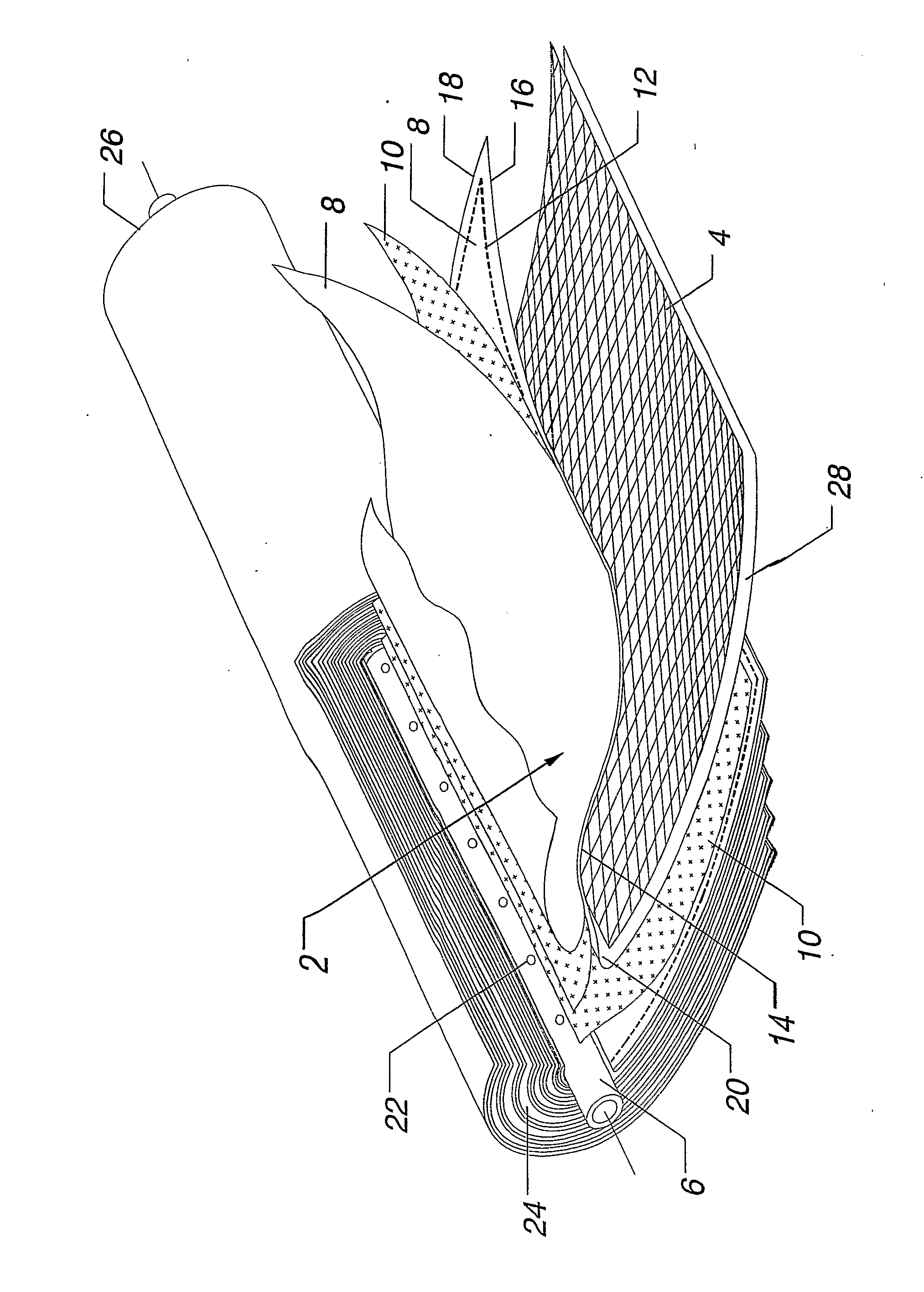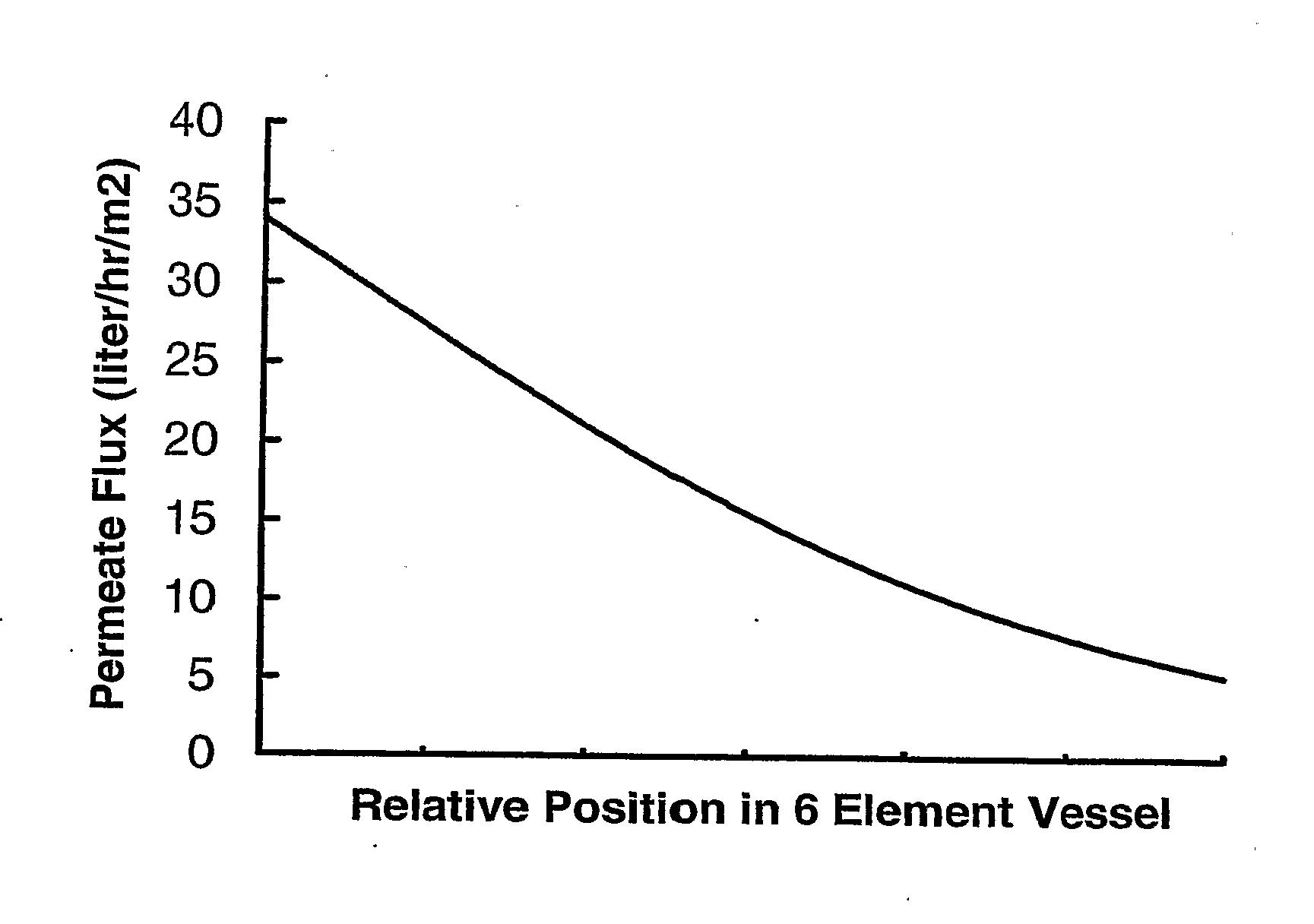Apparatus for Treating Solutions of High Osmotic Strength
a technology of osmotic strength and apparatus, which is applied in the direction of filtration separation, multi-stage water/sewage treatment, separation process, etc., can solve the problems of shortening the life of spiral wound elements, reducing the utilization of membranes, and pressure dropping down vessels, so as to improve the utilization of pressure vessels and improve the effect of osmotic strength and uniform flux distribution
- Summary
- Abstract
- Description
- Claims
- Application Information
AI Technical Summary
Benefits of technology
Problems solved by technology
Method used
Image
Examples
example 1
[0062] A membrane element was constructed using FILMTEC SW30HR membrane. Four elements having 2.6 m2 of active membrane area were constructed, using FILMTEC SW30SXLE membrane. Three of the SW30SXLE membrane elements were treated by immersing the membrane in an aqueous solution of 2000 ppm NaOCl for 30 minutes at pH was 10.5. Table 3 shows the measured standard specific flux and standard solute permeability for these elements.
TABLE 3Elements described in Example 1StandardSpecific FluxStandard SoluteL / m2 / PermeabilityElementMembranehr / bar(gfd / psi)L / m2 / hr(gfd)ASW30HR1.07(0.043)0.29(0.17)BSW30XLE1.43(0.058)0.45(0.26)CSW30XLE (treated)2.12(0.086)0.33(0.19)DSW30XLE (treated)1.85(0.075)0.32(0.19)ESW30XLE (treated)1.99(0.082)0.20(0.12)
[0063] Elements A, B, and C were loaded into a vessel, so that element A was in the lead the position and element C was in the tail position. Permeate flow was blocked between elements B and C to allow the permeate solution from element C to be collected sepa...
example 2
[0065] Two FILMTEC SW30XLE-380 elements were treated by immersing for 30 minutes in an aqueous solution of 1500 ppm and 2000 ppm, respectively, of NaOCl at pH 10.5. The elements had standard specific flux and standard solute permeability values shown in rows H and I of Table 4. In addition, the standard specific flux and standard solute permeability values of FILMTEC SW30HR-380 and SW30XLE-380 elements not contacted with NaOCl are shown in rows F and G, respectively. The ratio of standard solute permeability to standard specific flux for the tail element (0.064) divided by the ratio of standard solute permeability to standard specific flux for the lead element (0.071) is less than 1. For all elements in Table 4, the standard pressure gradient was approximately 0.2 bar / m, and the feed spacer cross sectional area was approximately 230 cm2.
TABLE 4Elements described in Example 2StandardStandard SoluteSpecific FluxPermeabilityElementNaOClL / m2 / hr / bar(gfd / psi)L / m2 / hr(gfd)F0ppm0.96(0.039)...
example 4
[0075] Calculations were performed as in Example 3, using a 167 m3 / day (44000 gpd) feed of 3.5% seawater. An applied pressure of 79.3 bar (1150 psi) resulted in a simulated recovery of 60.8% for this vessel. In this case, seven elements within the vessel potentially differed in A values, B values and active area, as noted in the table. The combined permeate concentration was estimated at 448 ppm. Simulations show each element within this vessel to have low values for maximum flux, average flux and element recovery. Dividing the total permeate flow by the active membrane area provides an average flux for the vessel of 18.8 L / m2 / hr (11.1 gfd).
TABLE 8Flux distribution for Example 4AvgMaxAreaA valueB valueFluxFluxElement(m2)(Lmh / bar)(Lmh)(Lmh)(Lmh)Recovery135.30.6160.06826.528.213.8%233.00.7390.06826.128.714.4%333.00.8620.06823.326.314.9%430.71.2310.17021.225.514.9%530.72.4620.17017.322.714.3%630.72.4620.1709.512.69.2%730.72.4620.1705.37.05.6%
PUM
| Property | Measurement | Unit |
|---|---|---|
| Temperature | aaaaa | aaaaa |
| Fraction | aaaaa | aaaaa |
| Fraction | aaaaa | aaaaa |
Abstract
Description
Claims
Application Information
 Login to View More
Login to View More - R&D
- Intellectual Property
- Life Sciences
- Materials
- Tech Scout
- Unparalleled Data Quality
- Higher Quality Content
- 60% Fewer Hallucinations
Browse by: Latest US Patents, China's latest patents, Technical Efficacy Thesaurus, Application Domain, Technology Topic, Popular Technical Reports.
© 2025 PatSnap. All rights reserved.Legal|Privacy policy|Modern Slavery Act Transparency Statement|Sitemap|About US| Contact US: help@patsnap.com



